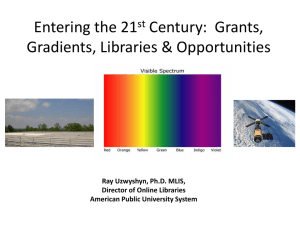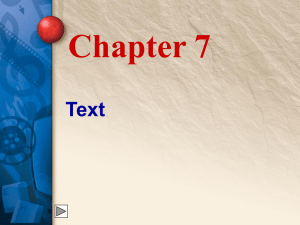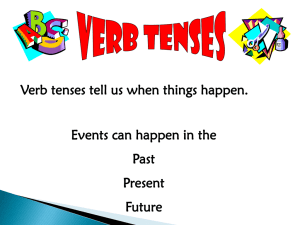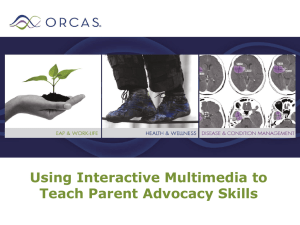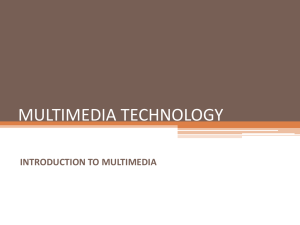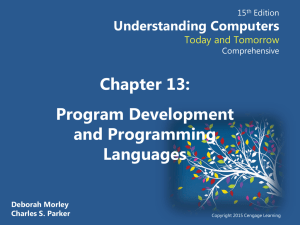morley15e__ppt_ch10 REV
advertisement
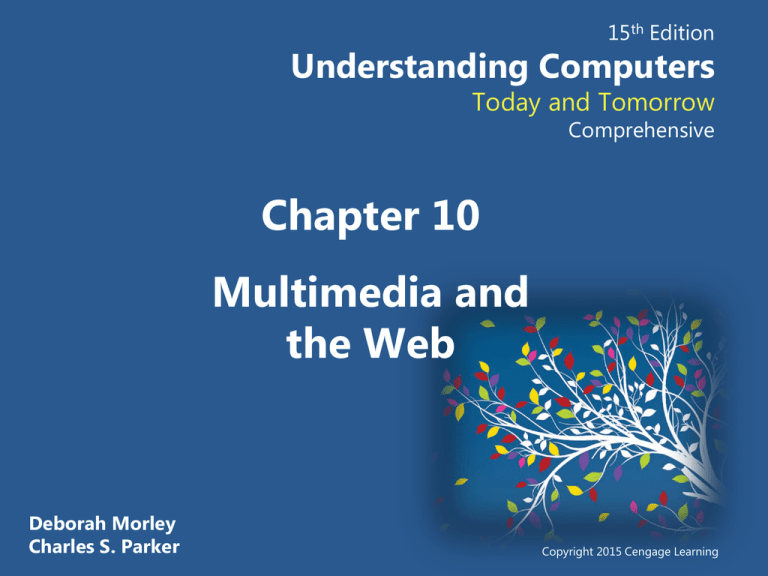
15th Edition Understanding Computers Today and Tomorrow Comprehensive Chapter 10 Multimedia and the Web Deborah Morley Charles S. Parker Copyright 2015 Cengage Learning Learning Objectives 1. Define Web-based multimedia and list some advantages and disadvantages of using multimedia. 2. Describe each of the following multimedia elements—text, images, animation, audio, and video—and tell how they differ. 3. Briefly describe the basic steps and principles involved with designing a multimedia Web site. 4. List the various tasks involved with developing a multimedia Web site. Understanding Computers: Today and Tomorrow, 15th Edition 22 Learning Objectives 5. Explain how markup languages, scripting languages, and other tools are used today to create multimedia Web pages. 6. Discuss the possible use of Web-based multimedia in the future. Understanding Computers: Today and Tomorrow, 15th Edition 3 Overview • This chapter covers: – What Web-based multimedia is and how it is used today – The advantages and disadvantages of using multimedia – Basic multimedia elements commonly found on Web pages – Steps and principles in designing a multimedia site – How a multimedia Web site is developed and the software used during this process – The future of Web-based multimedia Understanding Computers: Today and Tomorrow, 15th Edition 4 What Is Web-Based Multimedia? • Multimedia – The integration of a variety of media, such as text, images, video, animation, and sound • Web-Based Multimedia (also called rich media) – Multimedia (sound, video, animation) located on Web pages • Multimedia Sites – Are interactive – Often contain elements that users interact with directly – Display information as requested by the Web page visitor Understanding Computers: Today and Tomorrow, 15th Edition 5 What Is Web-Based Multimedia? • Fast computers and broadband Internet connections make Web-based multimedia much more feasible than in the past • Vast majority of Web sites today include multimedia (advertisements, TV shows, podcasts, user generated content) • Why Learn About Web-Based Multimedia? – Multimedia is an integral component of the Web – Businesses and individuals need to understand the characteristics of the various types of multimedia elements and the impact of adding them to a Web site Understanding Computers: Today and Tomorrow, 15th Edition 6 Web-Based Multimedia Applications • Information Delivery – Photos of products, video clips and podcasts, and users’ manuals are used to convey information – Important component in Web-based training (WBT) • E-Commerce – Online catalogs, samples of movies and music, etc. – Virtual Reality (VR) • The use of a computer to create three-dimensional environments that look like they do in the real world (i.e., homes for sale) • Augmented Virtual Reality - overlaying computer generated images on top of real time images Understanding Computers: Today and Tomorrow, 15th Edition 7 Web-Based Multimedia Applications • Entertainment – Online TV/movies and games are available through TV network sites • Social Media and Virtual Worlds – Photos and videos on many social networking sites – 3D Virtual Worlds (Second Life) Understanding Computers: Today and Tomorrow, 15th Edition 8 Web-Based Multimedia Applications Understanding Computers: Today and Tomorrow, 15th Edition 9 Advantages and Disadvantages of Web-Based Multimedia • Advantages – Can deliver some content that could not be delivered otherwise – Can address a variety of learning styles • Visual learners • Auditory learners • Kinesthetic learners – Material more interesting and enjoyable – Many ideas are easier to convey in multimedia format Understanding Computers: Today and Tomorrow, 15th Edition 10 Advantages and Disadvantages of Web-Based Multimedia • Disadvantages – Time and cost of development – The cost of hosting and delivering the multimedia needs to be considered – The impact on visitors that have slow Internet connections or low bandwidth caps Understanding Computers: Today and Tomorrow, 15th Edition 11 Inside the Industry Box Military Virtual Worlds – U.S. military simulations traditionally take months to develop – Virtual world simulations can be developed much more quickly and requires less personnel and skills – MOSES is a simulation created using an OpenSim grid – Can be secured behind firewall Understanding Computers: Today and Tomorrow, 15th Edition 12 Multimedia Elements • Text – Used to supply basic content, and to add text-based menus and hyperlinks – Serif Typeface • Small lines on edges of letters • More readable, used for large bodies of text – Sans Serif Typeface • No lines on edges of letters • Used for titles, headings, Web page banners Understanding Computers: Today and Tomorrow, 15th Edition 13 Multimedia Elements – Different typefaces can convey widely different feelings – Important to select a typeface that matches the style of the Web site – When a consistent text appearance is required (such as for a logo) an image containing the text is used instead • Images (Graphics) – Digital representations of photographs, drawings, charts, and other visual images • Images are static and are available in many formats— TIF, BMP, GIF, JPEG, and PNG • Clip art consists of pre-drawn images • Stock photos are also available online Understanding Computers: Today and Tomorrow, 15th Edition 14 Multimedia Elements Understanding Computers: Today and Tomorrow, 15th Edition 15 Multimedia Elements – GIF • Graphic Interchange Format • Commonly used for Web page images • Used with logos, banners, other nonphotographic images • 256 colors max • Uses lossless file compression • Can be transparent • Can be interlaced Understanding Computers: Today and Tomorrow, 15th Edition 16 Multimedia Elements Understanding Computers: Today and Tomorrow, 15th Edition 17 Multimedia Elements – PNG • Portable Network Graphics • Format designed specifically for use with Web page images in 1996 • Uses lossless compression • Can compress more efficiently than GIF • Can use specific color palette of 256 colors or true color palette of 16 million colors • Can also be transparent and interlaced Understanding Computers: Today and Tomorrow, 15th Edition 18 Multimedia Elements – JPEG • Joint Photographic Experts Group • Standard format for Web page photos • Uses lossy file compression – Image quality is lost during compression • Can use true color • Can be progressive • The amount of compression is specified when the file is saved Understanding Computers: Today and Tomorrow, 15th Edition 19 Multimedia Elements Understanding Computers: Today and Tomorrow, 15th Edition 20 Multimedia Elements – Choosing a Graphic Format • GIF or PNG—typically used for line art (clip art, logos, navigation buttons, etc.) • JPEG—typically used for photographs • Use thumbnail images when very large images are required Understanding Computers: Today and Tomorrow, 15th Edition 21 Multimedia Elements • Animation – A series of graphical images are displayed in succession to simulate movement – Java Applet • A small program inserted into a Web page that performs a specific task – Animated GIF • A group of GIF images saved as an animated GIF file that is inserted in a Web page • Displayed one after another to simulate movement Understanding Computers: Today and Tomorrow, 15th Edition 22 Multimedia Elements • For more complex animations, developers can use JavaScript or another scripting language – Flash, Silverlight • Many Wed-based animations require a plug-in • Animation and interactivity can also be achieved using programming languages – Audio • All types of sound including music, spoken voice, sound effects • Can be recorded using a microphone or MIDI instrument, captured from CDs, or downloaded from the Internet Understanding Computers: Today and Tomorrow, 15th Edition 23 Multimedia Elements – Often played when an event occurs on a Web page or when the visitor clicks a link – Streaming audio is used to speed up delivery – Common audio file formats include: • Waveform (.wav) • Moving Picture Experts Group Audio Layer 3 (.mp3) • Audio Interchange Format File (.aiff) • Advanced Audio Coding (.aac or .m4a) Understanding Computers: Today and Tomorrow, 15th Edition 24 How It Works Box MP3 Compression – Patented compression method; MPEG Audio Layer 3 – Typically compresses a CD-quality song to 1/10th of its size – Used with Internet music downloads – Uses perceptual coding and Huffman coding Understanding Computers: Today and Tomorrow, 15th Edition 25 Multimedia Elements – Video • Begins as a continuous stream of visual information, which is then broken into separate images (frames) when the video is recorded • Video data, like audio data, is usually compressed • Streaming video is recommended to speed up delivery • Common video file formats include: .avi .mp2 .mov .flv .mp4 .wmv Understanding Computers: Today and Tomorrow, 15th Edition 26 Quick Quiz 1. The most common file format for Web page photographs is __________. a. GIF b. JPEG c. PNG 2. True or False: Delivery speed is one potential disadvantage of using Web-based multimedia. 3. A small image that is linked to a larger version of the same image is called a(n) __________. Answers: 1) b; 2) True; 3) thumbnail image Understanding Computers: Today and Tomorrow, 15th Edition 27 Multimedia Web Site Design • Web Site Design – The process of planning what a Web site will look like and how it will function – Good planning is very important • Basic Design Principles – Web pages should be interesting and exciting applications • Provide information of value or interest • Provide a stimulating experience – Pages should load quickly and be easy to use Understanding Computers: Today and Tomorrow, 15th Edition 28 Multimedia Web Site Design • Plan for all needed delivery methods and devices – Features that require a specific browser – Features that require little used plug-ins – The size of the page content • Different devices, browsers, and screen resolutions affect how Web pages display – High-bandwidth items • Watch image file size (use thumbnails) • Use links to audio, video, and other high-bandwidth items • Use streaming audio and video Understanding Computers: Today and Tomorrow, 15th Edition 29 Technology and You Box Responsive Web Design (RWD) – Focuses on building sites that are compatible with a variety of devices – Can create multiple versions of your site yourself or use a flexible site that adjusts to each visitor’s device – Can create a desktop site and use a service to generate mobile versions Understanding Computers: Today and Tomorrow, 15th Edition 30 Determining the Objectives and Intended Audience of the Site • One of the first steps in designing a multimedia application or Web site • Objectives of the site affect its content – Main purpose – Supplemental activities and social media tie-ins • Intended audience affects the appearance (such as the style, graphics, fonts, and colors) of the site • Once the objectives and audience have been identified, you should have a good idea of the main topics to be included in the site Understanding Computers: Today and Tomorrow, 15th Edition 31 Using Flowcharts, Page Layouts, and Storyboards • Flowchart – Used during the Web design process to illustrate how the pages in a Web site relate to one another • Page Layout – Illustrates the basic layout and navigational structure of a Web site – Typically two are created: one for the home page and one for the rest of the pages in the site • Storyboard – Ordered series of sketches showing each page or screen in an animation sequence Understanding Computers: Today and Tomorrow, 15th Edition 32 Using Flowcharts, Page Layouts, and Storyboards Understanding Computers: Today and Tomorrow, 15th Edition 33 Navigational Design Considerations • Users should be able to get to most pages on the site within three mouse clicks – Using site maps and drop-down menus with larger Web sites will help • Navigational items should be placed in the same location on every page • Break long pages into multiple pages • Add a text name to images • A link to the home page should appear on every page • Include identifying information on each page to indicate which page is currently displayed Understanding Computers: Today and Tomorrow, 15th Edition 34 Navigational Design Considerations Understanding Computers: Today and Tomorrow, 15th Edition 35 Access Considerations • Device Compatibility – The device being used to access a Web site affects how the site will appear and how functional it will be – Develop a plan for mobile access of your site • Assistive Technology – Hardware and software specially designed for individuals with physical disabilities • Screen readers and Braille displays • Alternative text (alt tags) – Also watch reading level of site Understanding Computers: Today and Tomorrow, 15th Edition 36 Access Considerations Understanding Computers: Today and Tomorrow, 15th Edition 37 Quick Quiz 1. Which of the following is most often used to illustrate what a Web page will look like? a. Flowchart b. Storyboard c. Page layout 2. True or False: In order for a screen reading program to identify an image-based hyperlink, alternative text must be assigned to that image. 3. A Web page that contains links to all the main pages on a Web site is called a(n) __________. Answers: 1) c; 2) True; 3) site map Understanding Computers: Today and Tomorrow, 15th Edition 38 Multimedia Web Site Development • Web Site Development – The process of creating, testing, publishing, and maintaining a Web site • Occurs after the site is designed • Can be performed in-house or outsourced • Creating the Multimedia Elements – Usually several different software programs are used • Image editing and animation software • Audio and video editing software – Each element should be saved in the appropriate size, resolution, and file format Understanding Computers: Today and Tomorrow, 15th Edition 39 Multimedia Web Site Development • Creating the Web Site – Markup Language • Uses symbols or tags to describe what a document should look like when it is displayed in a Web browser – JavaScript or other scripting languages can be used to add dynamic content – Web site authoring software is often used to create an entire site Understanding Computers: Today and Tomorrow, 15th Edition 40 Multimedia Web Site Development • Hypertext Markup Language (HTML) – The original markup language – Uses HTML tags to indicate where effects and elements belong in the Web page – Some tags are paired – The computer and browser being used still determines exactly how the Web page will display Understanding Computers: Today and Tomorrow, 15th Edition 41 Multimedia Web Site Development Understanding Computers: Today and Tomorrow, 15th Edition 42 Multimedia Web Site Development • Extensible Markup Language (XML) – A set of rules for exchanging data over the Web – Addresses the content but not the formatting – Uses XML tags to identify data – Allows data to be extracted and reused as needed • Extensible Hypertext Markup Language (XHTML) – A newer version of HTML based on XML – Controls the appearance and format of a Web page like HTML – Stricter rules than HTML Understanding Computers: Today and Tomorrow, 15th Edition 43 Multimedia Web Site Development • HTML5 – Newest version is designed to replace the previous versions of both HTML and XHTML – Includes new tags and features that support the creation of more complex and dynamic Web pages – Is open standard – No proprietary software or plug-ins required – New tags include <video> and <audio> for media, <canvas> that creates a bitmapped surface to work with, and section tags to identify the parts of a Web page (<header>, <article>, <nav>, etc.) Understanding Computers: Today and Tomorrow, 15th Edition 44 Multimedia Web Site Development Understanding Computers: Today and Tomorrow, 15th Edition 45 Multimedia Web Site Development • Cascading Style Sheets (CSSs) – Used to specify the styles used with a Web page or an entire Web site – Specified in an Internal style sheet (head section of Web page) or in an External style sheet • Normally used in an external style sheet and connected to web pages through a link statement in the head section of the desired pages • Styles are applied to all of the linked Web pages at one time – Improves consistency and efficiency Understanding Computers: Today and Tomorrow, 15th Edition 46 Multimedia Web Site Development • Wireless Markup Language (WML) – Used to create Web pages to be displayed on WAPenabled wireless devices, such some older mobile phones • Scripting Languages – Used with Web pages with lots of dynamic content • Allows the inclusion of scripts (instructions) in the Web page code • JavaScript, VBScript, Perl Understanding Computers: Today and Tomorrow, 15th Edition 47 Multimedia Web Site Development • AJAX – Creates faster, more efficient interactive Web applications – Only requests new data from the server, not the entire Web page, when the page is updated – Interactive Web pages built with AJAX run faster – Normally require less bandwidth than conventional Web applications Understanding Computers: Today and Tomorrow, 15th Edition 48 Multimedia Web Site Development • ActiveX – Set of specifications for reusing software components that can be sued to integrate multimedia and other interactive elements into Web pages – Extends OLE (Object Linking and Embedding) to integrate content from two or more programs – Allows a variety of types of Windows files to be viewed via Web pages • Virtual Reality Modeling Language (VRML) and X3D – A language used to create 3D Web pages – Successor is X3D Understanding Computers: Today and Tomorrow, 15th Edition 49 Trend Box Push Technology and xRTML – Conventional Web pages have the user pull data from the server – Push technology delivers content automatically as it becomes available – One emerging option for Web sites and apps for all devices is xRTML – Delivers data in a timely manner and saves data transfer costs Understanding Computers: Today and Tomorrow, 15th Edition 50 Multimedia Web Site Development • Web Site Authoring Software – Used to create Web pages and entire Web sites (Dreamweaver) – Appropriate JavaScript or other code is automatically generated – Allows you to create an entire cohesive Web site, not just individual pages – Allows you to easily include forms and database connectivity – Often includes tests for broken links & accessibility tests – Web site builder – cloud versions Understanding Computers: Today and Tomorrow, 15th Edition 51 Multimedia Web Site Development Understanding Computers: Today and Tomorrow, 15th Edition 52 Testing, Publishing, and Maintaining the Site • Web site should be thoroughly tested prior to publishing – All hyperlinks should be clicked to ensure they take the user to the proper location – Complex animations (such as games and tutorials) should be tested individually – Proofread each page or screen carefully – Use Web page code validators built into Web site authoring programs or online validator services – Consider a “stress test” Understanding Computers: Today and Tomorrow, 15th Edition 53 Testing, Publishing, and Maintaining the Site Understanding Computers: Today and Tomorrow, 15th Edition 54 Testing, Publishing, and Maintaining the Site • Once thoroughly tested, Web site is ready to be published – Identify Web server – Upload files • After publishing, the Web site must be maintained – Update content and check links on a regular basis – Site should be evaluated on a regular basis to locate areas needing improvement Understanding Computers: Today and Tomorrow, 15th Edition 55 The Future of Web-Based Multimedia • Web-based multimedia will be more exciting and more embedded into everyday events • Web-based content, cloud services, and home entertainment devices will likely continue to converge to allow seamless access to desired content on the user’s device of choice • Technology will evolve to support mobile multimedia • Usage of multimedia applications that are tied to a geographical location or current status and that involve usergenerated content will also likely continue to grow Understanding Computers: Today and Tomorrow, 15th Edition 56 Quick Quiz 1. Which of the following markup languages is most often used to create Web pages? a. HTML b. JavaScript c. WML 2. True or False: Web site authoring software can typically be used to create all of the Web pages on a site, including adding animated elements, video clips, etc. 3. The HTML code __________ would begin to bold Web page text. Answers: 1) a; 2) True; 3) <b> Understanding Computers: Today and Tomorrow, 15th Edition 57 Summary • • • • • What is Web-Based Multimedia? Multimedia Elements Multimedia Web Site Design Multimedia Web Site Development The Future of Web-Based Multimedia Understanding Computers: Today and Tomorrow, 15th Edition 58

